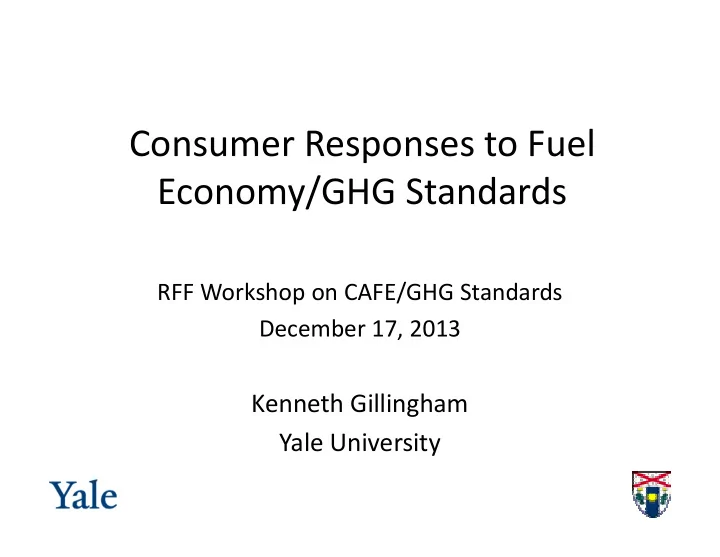

Consumer Responses to Fuel Economy/GHG Standards RFF Workshop on CAFE/GHG Standards December 17, 2013 Kenneth Gillingham Yale University
Topics I Will Address Today • Some thinking on the “rebound effect” – Microeconomic – Macroeconomic • Relevant work-in-progress Time permitting: • Vehicle choice modeling results on vehicle price and cross-price elasticities
Rebound Effect These thoughts are primarily from a paper co-authored with David Rapson and Gernot Wagner (in review at REEP) Key questions: • When we increase fuel economy… – How much more will people drive? – How much will they spend on other goods and services? – How much will other countries increase oil consumption? – How much substitution to vehicles will there be?
Microeconomic Rebound Effect This is just the substitution and income effect • Lower the cost per mi of driving and consumers substitute towards more driving • If they spend less on driving, they may spend more on other energy-using goods or services Both will reduce energy and GHG savings… …question is “how much?”
Microeconomic Rebound Effect To quantify: • Use price elasticities of demand for the substitution effect and “a slice” of the income effect (direct effect) – Not perfect, several caveats – Estimates range widely – Our view: most reliable estimates range from -0.05 to -0.3 • Ideally use estimates of where the next marginal dollar is spent for the remaining income effect (indirect effect) – Estimates using average spending tend to hover around 0.1 Note a higher direct effect means a lower indirect effect
What We Want to Know Can we use a fuel price elasticity of driving demand? • Or do consumers respond differently to fuel prices than to – changes in fuel economy? How does this effect vary… • Across states? – Across different income groups? – Across different geographic areas? – Across different types of vehicles (Chris’ work) – Will the increase in vehicle cost from standards • eliminate the income/indirect effect?
What We Want to Know
Macroeconomic Leakage Rebound Consider the global oil market If we reduce oil use in the US, what happens? • Oil demand shifts in and the global price drops – Other countries demand more oil as the market re- – equilibrates This effect could be large and should be examined • more carefully
Macroeconomic Growth Rebound 1. Sectoral Reallocation Substitution effects at a macro level – Size depends on whether energy services and other – goods/services are complements or substitutes 2. Induced Innovation Is there induced innovation that leads to more energy use? – No solid evidence currently, also depends on counterfactual – Note clearly welfare-improving – 3. Fiscal Multiplier effect Exacerbates above effects when there are “idle resources” – Debate in macro literature as to magnitude –
Macroeconomic Growth Rebound One key point: If the energy efficiency policy has a significant cost, we should not worry about the macro growth rebound effect But unanswered questions with little to guide us: • How large is the sectoral reallocation? • Do we really see induced innovation leading to more energy use?
Work-in-Progress on the Elasticity of Driving • Heterogeneity by demographics (CA data) – Distributional consequences of policy • Difference in fuel price and fuel economy elasticity – Plan to examine across several states (CA/CT/MA) • Heterogeneity in the elasticity of driving (PA data) • Prius Fallacy – MA annual inspection data • Driving elasticity and access to public transport – Data from Denmark
Other Relevant Work-in-Progress • Dynamic modeling of fleet turnover and utilization – Modeling the purchase, use, and scrappage decision in CA • Dynamic modeling of the diffusion of EVs – Modeling the buy-or-wait decision of EV purchasers in CA • Theoretical work on feebates versus CAFE standards – A feebate can be designed to exactly match any CAFE standard – A parallel distinction between feebates vesus CAFE and a carbon tax versus a cap-and-trade under uncertainty
Price Elasticities of Demand for Cars Two components 1. Own-price elasticity: how will the sales of vehicles change? 2. Cross-price elasticities: how will the sales of different vehicles change when prices of other vehicles change? Useful for understanding how the fleet will evolve under CAFE/GHG standards. – Of course, complicated by other attribute changes
Price Elasticities of Demand for Cars Gillingham (2012) estimates a vehicle choice model for new vehicles in California These estimates are updated preliminary estimates based on the latest estimation: • Own-price elasticity: varies by make/model, but is largely in the range of 1 • Cross-price elasticity: again varies by make/model. Key point is that it is small across classes and large within classes These estimates are consistent with older estimates (e.g., BLP)
Recommend
More recommend